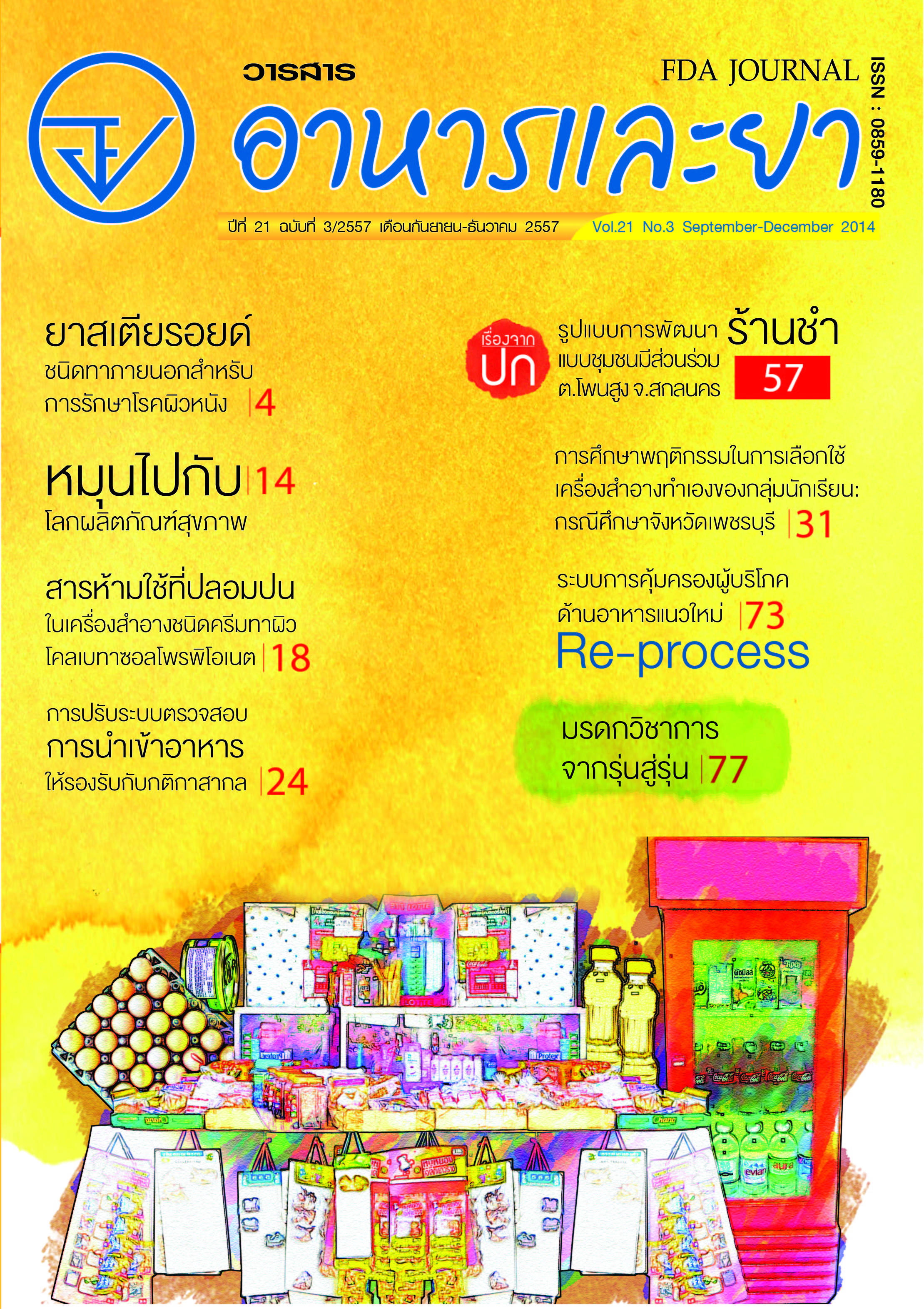การศึกษาพฤติกรรมในการเลือกใ้ช้เครื่องสำอางทำเองของกลุ่มนักเรียน : กรณีศึกษาจังหวัดเพชรบุรี
Main Article Content
บทคัดย่อ
การศึกษาพฤติกรรมในการเลือกใช้เครื่องสําาอางทําาเองของกลุ่มนักเรียน: กรณีศึกษา จังหวัดเพชรบุรี
เป็นการวิจัยเชิงคุณภาพ วัตถุประสงค์เพื่อศึกษาพฤติกรรมในการเลือกใช้เครื่องส
ําาอางท
ําาเองของกลุ่มนักเรียน
จนเกิดอาการขาลาย และศึกษาเส้นทางการได้มาจนถึงการน
ําาเครื่องส
ําาอางท
ําาเองมาใช้ โดยศึกษาในกลุ่ม
ตัวอย่างของนักเรียนที่มีอาการขาลาย จากโรงเรียน 2 แห่ง เก็บรวบรวมข้อมูล โดยการสนทนากลุ่ม และ
หาข้อมูลเชิงลึก ในช่วงเดือนมิถุนายน–กันยายน 2556 ผลการศึกษาพบว่า ปัจจัยสําาคัญที่เด็กนักเรียนเลือกใช้
เครื่องส
ําาอางท
ําาเอง คือ ปัจจัยค่านิยมทางสังคม คือ การชื่นชอบคนผิวขาวและคิดว่าตนเองมีผิวสีด
ําา หรือการมี
คนอ้างอิง ที่มีประสบการณ์ในการใช้เครื่องส
ําาอางท
ําาเองแนะน
ําาให้ใช้ ปัจจัยส่วนบุคคล คือ รายได้ เด็กนักเรียน
ที่มีรายได้สูงจะสั่งซื้อเครื่องส
ําาอางครีมท
ําาเองส
ําาเร็จรูป ส่วนเด็กนักเรียนที่มีรายได้ปานกลางหรือต
ํา
่า จะน
ําา
เครื่องส
ําาอางชนิดต่างๆ มาผสมท
ําาเอง เนื่องจากราคาถูกหาซื้อได้ง่าย ส
ําาหรับเส้นทางแหล่งที่มาของเครื่องส
ําาอางครีม
ทําาเอง คือ ร้านขายเครื่องสําาอางทั่วไป ร้านเสริมสวย หรือ บุคคลที่เคยศึกษาหรือศึกษาในสถาบันอุดมศึกษา
ข้อเสนอแนะ ส
ําานักงานคณะกรรมการอาหารและยาควรมีการศึกษาและรวบรวมสารห้ามใช้หรือ
สารที่เป็นอันตรายอื่นๆ ต่อผู้บริโภคที่สามารถหาซื้อได้ง่ายตามท้องตลาด และมีแนวโน้มน
ําาไปใช้ในทางที่ผิด
เพื่อก
ําาหนดเป็นนโยบายในการประชาสัมพันธ์ ควรมีนโยบายในเชิงรุกต่อสถาบันการศึกษาต่างๆ ในการให้ความรู้
ด้านกฎหมายเครื่องส
ําาอาง ควรใช้มาตรการทางกฎหมายต่อสถานที่จ
ําาหน่ายเครื่องส
ําาอาง ที่มีการจ
ําาหน่าย
เครื่องส
ําาอางที่ไม่ปลอดภัยต่อผู้บริโภคอย่างเข้มงวด ควรพัฒนาฐานข้อมูลวัตถุดิบ เช่น สารไฮโดรควิโนน
สารสเตียรอยด์ เป็นต้น ที่น
ําามาใช้ในอุตสาหกรรมประเภทต่างๆ เพื่อก
ําาหนดนโยบายในการควบคุมก
ําากับมิให้
สารดังกล่าวรั่วไหล ควรเพิ่มศักยภาพผู้บริโภคให้มีความรู้ และความเข้าใจ หลักการเลือกซื้อผลิตภัณฑ์
เครื่องส
ําาอางที่ถูกต้อง และสิทธิผู้บริโภค ควรพัฒนาระบบการเฝ้าระวังผลิตภัณฑ์สุขภาพที่ไม่ปลอดภัยที่เชื่อมโยง
ทั้งระบบ และควรมีการคืนข้อมูลสู่ชุมชน เพื่อใช้เป็นข้อมูลในการพัฒนากลไกการเฝ้าระวัง หรือแจ้งเตือนภัย
ในชุมชน
เป็นการวิจัยเชิงคุณภาพ วัตถุประสงค์เพื่อศึกษาพฤติกรรมในการเลือกใช้เครื่องส
ําาอางท
ําาเองของกลุ่มนักเรียน
จนเกิดอาการขาลาย และศึกษาเส้นทางการได้มาจนถึงการน
ําาเครื่องส
ําาอางท
ําาเองมาใช้ โดยศึกษาในกลุ่ม
ตัวอย่างของนักเรียนที่มีอาการขาลาย จากโรงเรียน 2 แห่ง เก็บรวบรวมข้อมูล โดยการสนทนากลุ่ม และ
หาข้อมูลเชิงลึก ในช่วงเดือนมิถุนายน–กันยายน 2556 ผลการศึกษาพบว่า ปัจจัยสําาคัญที่เด็กนักเรียนเลือกใช้
เครื่องส
ําาอางท
ําาเอง คือ ปัจจัยค่านิยมทางสังคม คือ การชื่นชอบคนผิวขาวและคิดว่าตนเองมีผิวสีด
ําา หรือการมี
คนอ้างอิง ที่มีประสบการณ์ในการใช้เครื่องส
ําาอางท
ําาเองแนะน
ําาให้ใช้ ปัจจัยส่วนบุคคล คือ รายได้ เด็กนักเรียน
ที่มีรายได้สูงจะสั่งซื้อเครื่องส
ําาอางครีมท
ําาเองส
ําาเร็จรูป ส่วนเด็กนักเรียนที่มีรายได้ปานกลางหรือต
ํา
่า จะน
ําา
เครื่องส
ําาอางชนิดต่างๆ มาผสมท
ําาเอง เนื่องจากราคาถูกหาซื้อได้ง่าย ส
ําาหรับเส้นทางแหล่งที่มาของเครื่องส
ําาอางครีม
ทําาเอง คือ ร้านขายเครื่องสําาอางทั่วไป ร้านเสริมสวย หรือ บุคคลที่เคยศึกษาหรือศึกษาในสถาบันอุดมศึกษา
ข้อเสนอแนะ ส
ําานักงานคณะกรรมการอาหารและยาควรมีการศึกษาและรวบรวมสารห้ามใช้หรือ
สารที่เป็นอันตรายอื่นๆ ต่อผู้บริโภคที่สามารถหาซื้อได้ง่ายตามท้องตลาด และมีแนวโน้มน
ําาไปใช้ในทางที่ผิด
เพื่อก
ําาหนดเป็นนโยบายในการประชาสัมพันธ์ ควรมีนโยบายในเชิงรุกต่อสถาบันการศึกษาต่างๆ ในการให้ความรู้
ด้านกฎหมายเครื่องส
ําาอาง ควรใช้มาตรการทางกฎหมายต่อสถานที่จ
ําาหน่ายเครื่องส
ําาอาง ที่มีการจ
ําาหน่าย
เครื่องส
ําาอางที่ไม่ปลอดภัยต่อผู้บริโภคอย่างเข้มงวด ควรพัฒนาฐานข้อมูลวัตถุดิบ เช่น สารไฮโดรควิโนน
สารสเตียรอยด์ เป็นต้น ที่น
ําามาใช้ในอุตสาหกรรมประเภทต่างๆ เพื่อก
ําาหนดนโยบายในการควบคุมก
ําากับมิให้
สารดังกล่าวรั่วไหล ควรเพิ่มศักยภาพผู้บริโภคให้มีความรู้ และความเข้าใจ หลักการเลือกซื้อผลิตภัณฑ์
เครื่องส
ําาอางที่ถูกต้อง และสิทธิผู้บริโภค ควรพัฒนาระบบการเฝ้าระวังผลิตภัณฑ์สุขภาพที่ไม่ปลอดภัยที่เชื่อมโยง
ทั้งระบบ และควรมีการคืนข้อมูลสู่ชุมชน เพื่อใช้เป็นข้อมูลในการพัฒนากลไกการเฝ้าระวัง หรือแจ้งเตือนภัย
ในชุมชน
Article Details
รูปแบบการอ้างอิง
1.
จำแนกพล เ. การศึกษาพฤติกรรมในการเลือกใ้ช้เครื่องสำอางทำเองของกลุ่มนักเรียน : กรณีศึกษาจังหวัดเพชรบุรี. TFDJ [อินเทอร์เน็ต]. 8 สิงหาคม 2018 [อ้างถึง 26 ธันวาคม 2025];21(3):31-8. available at: https://he01.tci-thaijo.org/index.php/fdajournal/article/view/139049
ประเภทบทความ
รายงานการวิจัย


